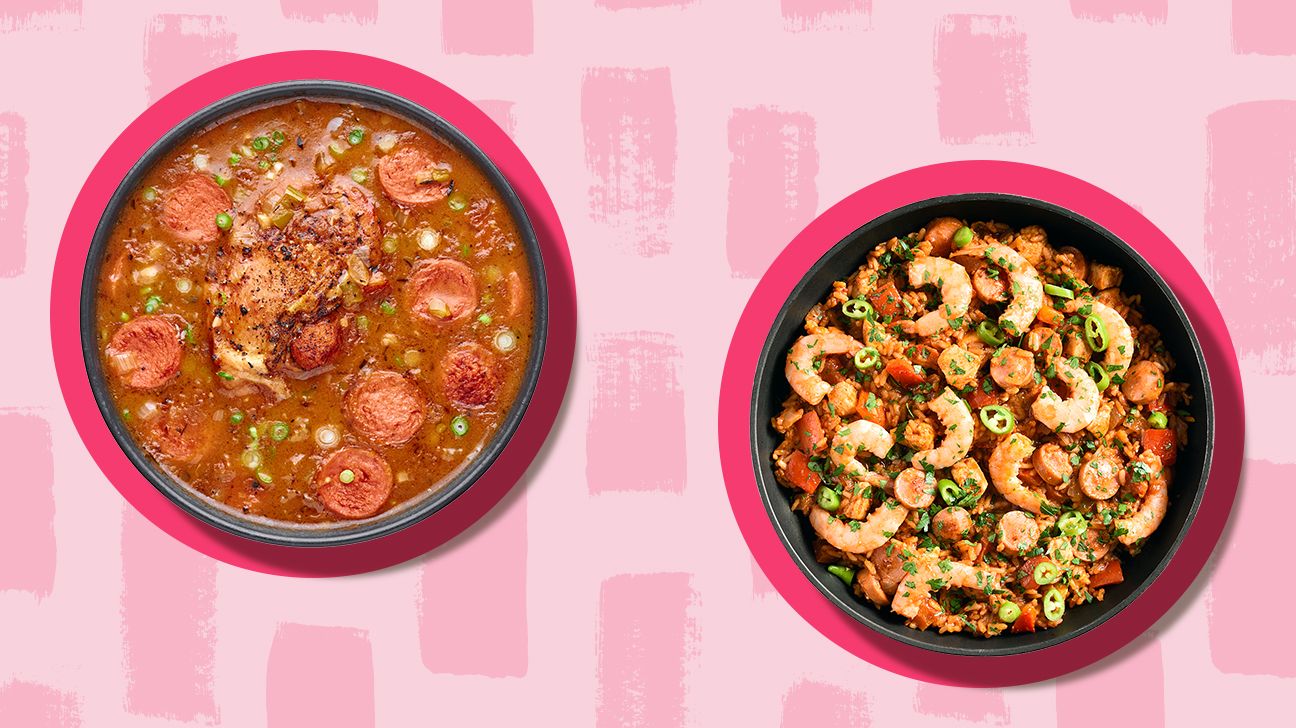Whether you’re a New Orleans native or are just passing through, you’re near-guaranteed to run into two classic dishes: gumbo and jambalaya. These two Southern staples are both flavorful, hearty dishes associated with the Big Easy — and we wouldn’t turn down either — but what exactly is the difference between the two?
We’re breaking down the subtle contrasts between these iconic Southern stews.
Gumbo is a Creole dish descended from many different culinary heritages. A very hearty soup or stew, gumbo can contain a variety of different meat or seafood combinations — chicken, andouille sausage, shrimp, crab, and oysters are all very popular. It also frequently features okra and tomatoes.
Gumbo starts with what Louisianans call the “holy trinity” of vegetables (celery, bell pepper, and onion, for the uninitiated). It’s then thickened with okra, filé powder (a spicy herb made from grinding sassafras leaves), or a roux (a mix of melted butter and flour).
Some gumbo chefs let their butter and flour cook an extra-long time, creating a browner, more richly flavored “dark roux.”
There are tons of styles of gumbo — Cajun, Creole, and gumbo z’herbes (a meatless variation), to name a few. The recipe’s basic formula is easy to personalize based on taste. Gumbo is simmered for several hours and is almost universally served over rice.
TBH, there’s lots of overlap in many jambalaya and gumbo recipes, as similar seasonings, broths, meats, and vegetables are used. Jambalaya is similar to gumbo in that it’s a stew made from meat and vegetables (and includes the “holy trinity” as a base).
That said, gumbo and jambalaya aren’t total twins. For starters, jambalaya doesn’t include the okra or filé powder as a thickener. In fact, most jambalayas don’t use any thickener at all — not even a roux.
The other primary difference between the two stews: the use of rice. Like gumbo, jambalaya is prepared with rice, but rather than sitting atop a bed of the grains, the rice is integrated into the stew itself.
Some of the distinctions between gumbo and jambalaya may lie in their unique histories.
Early Spanish settlers in Louisiana brought with them the rice dish paella, which may have influenced the evolution of jambalaya. Like paella, jambalaya simmers rice along with other ingredients, often cooking meat separately by sautéing in a Dutch oven.
West African slaves in Louisiana introduced another precursor to jambalaya known as jollof rice. This traditional dish also cooks veggies, spices, and meat in a single pot with rice.
As for gumbo, there may be a link between this stew and the French bouillabaisse, or a traditional stew made by the Choctaw tribe. Intriguingly, though, the word “gumbo” comes from a West African word for okra — so it’s possible it has some African heritage as well.
Today, jambalaya and gumbo can contain any number of meats and seafood, including crawfish, shrimp, pork, and chicken, with varying levels of spice. Throughout the South, it’s hard to find any two cooks with the same recipe — to which we say “laissez les bon temps rouler!” The more variations, the better, y’all.
If you only remember one thing about the difference between gumbo and jambalaya, let it be that gumbo is served over rice, while jambalaya includes rice in the dish itself. But if you remember two things, add the fact that both stews have a rich heritage of both flavor and cultural influence.
Wanna try your hand at gumbolaya? Wait, we mean jambo. Uh — you know what we mean. Check out these meaty, veggie, rice-y recipes.
1. Chicken and andouille gumbo
A gumbo base made of vegetables (onion, bell peppers, tomatoes, celery, okra) and homemade Cajun seasoning make this a healthy recipe you can easily adjust based on your preferences. Substitute frozen veggies to save time.
Get our chicken and andouille gumbo recipe.
2. Slow cooker shrimp gumbo
If you’re looking for gumbo without the work (instead of a traditional gumbo roux, you brown flour in the oven before mixing with chicken stock), this recipe with andouille sausage and three pounds of shrimp is a winner. Use your slow cooker on a five-hour simmer for a fix-and-forget dinner that’ll make your house smell amazing.
Get our slow cooker shrimp gumbo recipe.
3. Easy chicken gumbo
A rotisserie chicken forms the base of this quick gumbo recipe that also includes 8 ounces of andouille sausage and chopped vegetables. By using the grocery store shortcut, you’ll shave a few hours of prep time and can be ready to eat in less than an hour.
Get our easy chicken gumbo recipe.
4. Chicken and andouille sausage jambalaya
An extremely filling dish that’s great for serving a crowd, this chicken and andouille sausage jambalaya has a ton of seasonings (paprika, cayenne pepper, garlic powder, onion powder, black and white pepper, salt, cumin, oregano, thyme, coriander, ground mustard, and celery salt — sound like enough?). But feel free to break out the hot sauce if you like more spice.
Get our chicken and andouille jambalaya recipe.
5. Shrimp and okra gumbo with tasso
What’s tasso, you ask? It’s a type of cured pork often used in Cajun dishes. If you can’t find any at your local supermarket, feel free to substitute pancetta or diced ham. Any type you use will meld beautifully with the veggies and spices in this yummy gumbo.


